Euphausiacea
(Krill)
Phylum Arthropoda
Subphylum Crustacea
Class Malacostraca
Number of families 2
Thumbnail description
Small marine crustaceans known as “krill” that are found in all the world’s oceans and are critical to the marine ecosystem, providing a link between plankton and larger species in the food chain
Photo: Krill (Euphausia superba) cooked by thermal water on Deception Island, Antarctica.
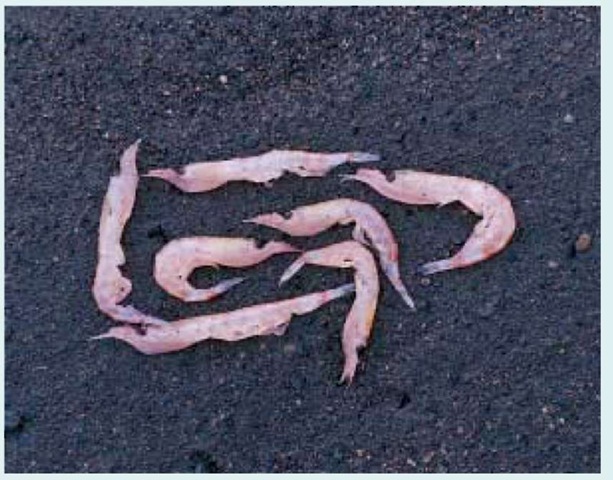
Evolution and systematics
The class Malacostraca comprises three subclasses: Eu-malacostraca, Hoplocarida, and Phyllocarida. The subclass Eumalacostraca comprises the superorders Eucarida, Pancar-ida, Peracarida, and Syncarida. The superorder Eucarida includes the order Decapoda (crabs, lobsters, crayfish, shrimp) and the order Euphausiacea.
There are two families within the order Euphausiacea: Eu-phausiidae and Bentheuphausiidae. Ten genera comprise the family: Euphausiidae Euphausia, Meganyctiphanes, Nematobra-chion, Nematoscelis, Nyctiphanes, Pseudeuphausia, Stylocheiron, Tessarabrachion, Thysanoessa, and Thysanopoda.
There is no fossil record of the order Euphausiacea. Today, the order includes about 85 species, of which five are found in the Antarctic, including the dominant Euphausia superba. The cold-adapted krill has benefited from climate change in the Antarctic, completely replacing the temperate-zone pelagic fishes that inhabited the region in the late Eocene.
Physical characteristics
Krill have the same basic body plan as other crustaceans such as lobsters or shrimp. Their elongated cephalothorax bears up to 13 pairs of limbs, 6-8 of which form a net-like structure, with bristles adapted for sieving food from the water. An additional five pairs of paddle-like limbs called swim-merets or pleopods, used for propelling the krill through the water, are found on the segmented abdomen and tail. Unlike more advanced crustaceans, however, euphausiids have exposed gills, which lie below the carapace.
Krill have two pairs of antennae, prominent compound eyes, and transparent skin with red spots of pigment. Mycosporine-like amino acids in their tissues, derived from algae they consume, absorb UV light and help to prevent sun damage. The gut is visible through the skin and may appear variously colored depending on their diet. Krill species range from less than 0.5 in (1.25 cm) to several inches (centimeters) in length.
Krill are sometimes called “light-shrimp,” a name deriving from bioluminescent organs on their eyestalks and body, called photophores, that produce a yellow-green or blue light. These may be used for mating displays or to confuse predators. The bioluminescent protein, luciferin, is believed to be obtained through consumption of dinoflagellates.
Distribution
Krill are found in all the world’s oceans, from tropical regions to the Arctic and Antarctic.
Habitat
Krill live in coastal waters, in the open ocean, and around sea ice. Most live within reach of the surface, where they feed and spawn, although there are a few little-known species living at depths of up to 16,400 ft (5,000 m).
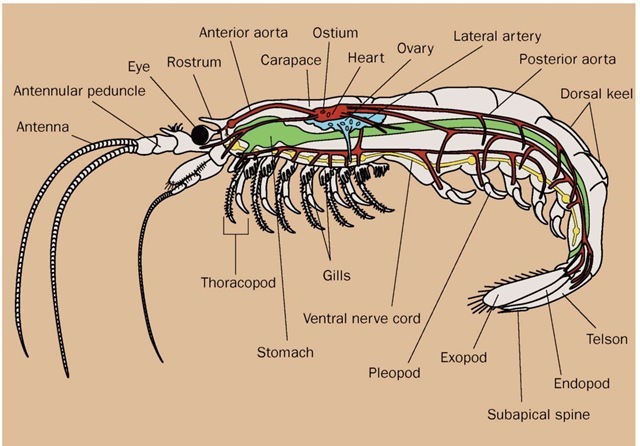
Krill anatomy.
Behavior
Eighteen krill species, including the most common varieties, have been observed to congregate in large groups called swarms. Depending on the species and location, krill swarms may pack as many as one million individuals, or hundreds of pounds (kilograms) of biomass, into each cubic foot (0.03 cubic m), and can extend over several hundred square miles (square kilometers). The density of organisms is not constant; in some areas, there may only be a few individuals per ft2 (0.09 m2). There may also be aggregations called shoals, less dense than swarms, with 10-100 krill per 35 cubic ft (1 cubic m). Swarming behavior is generally less apparent during the winter than at other times of year.
In most krill species, the swarms tend to be found at lower depths during the day to escape predation. The cooler temperatures also allow them to conserve energy by slowing their metabolism. At night, they rise to the surface in order to feed, accomplishing these vertical migrations through control of their buoyancy.
The pleopods of euphausiids allow them to maneuver, and in fact, being heavier than water, they must swim in order to stay afloat. They do this sporadically, alternating with periods of rest. Despite their swimming ability, krill do not propel themselves over large horizontal distances, and although not strictly planktonic (drifting) during most of their lifecy-cle, they are to some degree at the mercy of the current. However, by adjusting their buoyancy, they may be able to take advantage of current variations at different depths.
Feeding ecology and diet
Krill are generally surface feeders, and phytoplankton is an important component of their diet; it must grow where light is available for photosynthesis. Other elements of the diet, depending on the species, may include algae, diatoms, and cope-pods.
Krill filter their food from the water as they swim, using a “feeding basket” formed from bristles on their thoracic legs. As water is squeezed through the basket, the food is left behind, and the krill use their legs to convey it forward to their mouth.
An unusual adaptation seen in krill is the ability to reduce their size in response to scarcity of food. Unlike most other crustaceans, krill continue to molt throughout their lifespan. Under austere conditions, they may produce a new exoskeleton of a smaller size and shrink, using some of their body protein (they do not maintain significant fat stores) for fuel.
Krill are key organisms in the ecology of the oceans, providing an important food source not only for whales but also for other marine mammals, fishes, cephalopods, and sea birds. Their concentration in large swarms provides ample nutrition even for very large animals such as whales. Krill are critical in translating the food yield of plankton further up the food chain.
Reproductive biology
Reproduction only takes place where food is abundant; eggs are rich in lipids. Male krill produce spermatophores, which they transfer to the female using the uppermost abdominal appendages. The sperm is stored by the female and later released for fertilization as the eggs pass out of the genital opening. Females may spawn several times during the season, each brood consisting of thousands of free-floating eggs. Spawning occurs near the surface. The higher temperature of the shallow water allows faster development of the eggs, thereby limiting exposure to predators, and ensures that the offspring hatch into a food-rich environment.
After hatching as larvae, krill mature through juvenile stages (called nauplius, protozoea, zoea, and cyrtopia) into the adult form over a period of a few months, with segments and appendages as well as growth added at new molts.
Adult krill shed their sexual characteristics after the summer spawning season, and return to a juvenile-like state. They mature again in the spring. The krill lifespan is between two and 10 years, depending on the species.
Conservation status
Krill are abundant, and no species are listed by the IUCN. However, ecologists are wary of the possibility of over-fishing because of the key role that krill play in ocean ecosystems. Other potential threats to the krill population include habitat destruction and climate change.
Significance to humans
About 330,000 tons (300,000 kg) of krill per year are fished commercially, mostly for fish and animal feed. The largest single use is in aquaculture. Krill pigments are responsible for the pink color of salmon flesh, and krill-based feed is used extensively for farmed salmon as well as yellowtail and other fish.
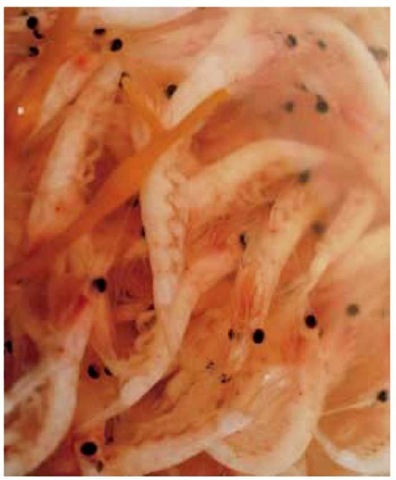
Northern krill (Meganyctiphanes norvegica) eat algae and zooplankton that live on ice.
In some regions such as Japan, krill products are produced for human consumption. Krill provide a plentiful, high-protein food source, but processing problems are significant. The organisms deteriorate quickly after death, because of the release of powerful digestive enzymes. In addition, their ex-oskeletons, which have a high-fluoride content, must be removed before the meat can be processed into food products for humans.
Other potential krill products being explored include food additives (proteins, omega-3 fatty acids) and enzymes and other biochemical products for pharmaceutical and industrial use.
In addition to harvesting the krill themselves, fishermen sometimes seek flocks of seabirds feeding on krill as indicators that a swarm is present and, therefore, other krill predators of interest, such as salmon, are probably in the vicinity.
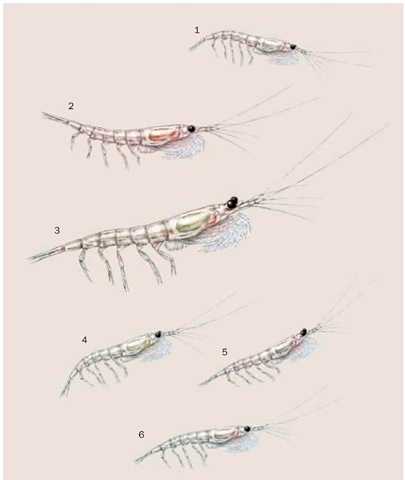
1. North Pacific krill (Euphausia pacifica); 2. Nordic krill (Meganyctiphanes norvegica); 3. Antarctic krill (Euphausia superba); 4. Thysanoessa in-ermis; 5. Thysanoessa spinifera; 6. Thysanoessa raschii.
Species accounts
North Pacific krill
Euphausia pacifica
FAMILY
Euphausiidae
TAXONOMY
Euphausia pacifica Hansen, 1911.
OTHER COMMON NAMES
Japanese: Isada.
PHYSICAL CHARACTERISTICS
About 0.75 in (1.9 cm) long, weighing about 0.003 oz (0.1 g).
DISTRIBUTION
North Pacific Ocean, from North America to Japan.
HABITAT
Open water, beyond the continental shelves or at their edges. Observed from the surface to about 984 ft (300 m) in depth.
BEHAVIOR
Migrates vertically to the food-rich sea surface in the early part of the night, feeds, and then sinks again upon satiation. Tends not to feed during the day even if food is relatively abundant below the surface.
FEEDING ECOLOGY AND DIET
Diet consists of phytoplankton and zooplankton. Predators include salmon, cod, herring, halibut, rockfish, whales, and seabirds.
REPRODUCTIVE BIOLOGY
Lifespan is about two years, somewhat longer for females. In general, females take part in two spawning seasons, while males take part in only one.
CONSERVATION STATUS
Not listed by the IUCN. One of the most common krill species along the west coast of North America.
SIGNIFICANCE TO HUMANS
Studies have been done to determine the feasibility of establishing fisheries off the California coast; this species makes up about 70% of the harvest of a controlled active krill fishery in British Columbia, products of which are mainly used in fish feed for aquaculture and aquaria. Also fished commercially off the coast of Japan.
Antarctic krill
Euphausia superba
FAMILY
Euphausiidae
TAXONOMY
Euphausia superba Dana, 1850.
OTHER COMMON NAMES
English: Southern krill.
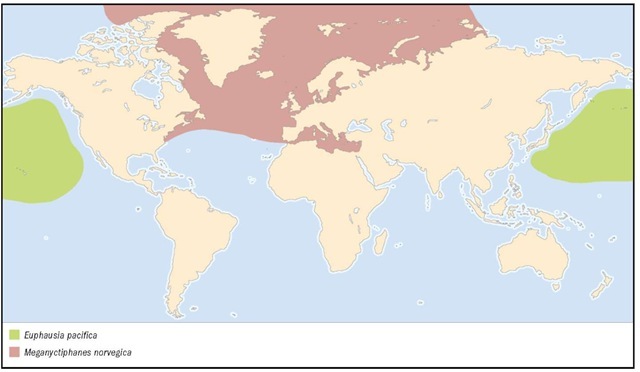
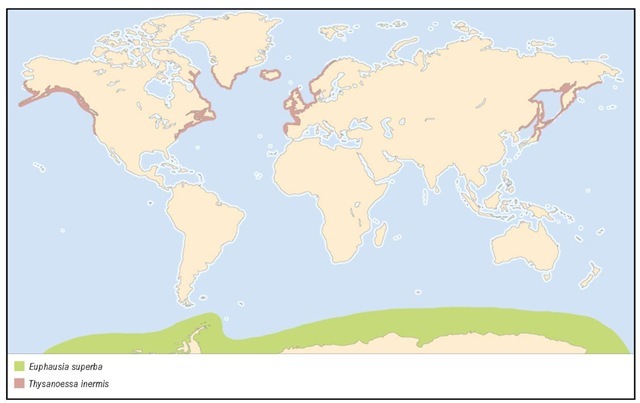
PHYSICAL CHARACTERISTICS
Among the largest species of krill; up to 2.5 in (6.5 cm) in length at maturity and weighing up to 0.07 oz (2 g). Gut appears green from predominance of phytoplankton in diet.
DISTRIBUTION
Southern ocean around Antarctica, over an area of about 13,500,000 mi2 (35,000,000 km2), almost five times the area of Australia.
HABITAT
Found from the surface to about 1,640 ft (500 m) depth. They congregate under and around sea ice edges to feed. Swarms may extend under the sea ice to about 8 mi (13 km) in from the edge, especially in the winter. Areas just south of sea ice edges have been found to have especially high krill densities. Juveniles in particular seek haven from predators in small crevices in the ice. Larger topographical features under the ice such as keels and pressure ridges also attract higher krill densities.
BEHAVIOR
Density in swarms may be as high as 30,000 krill per 35 cubic ft (1 cubic m). Some swarms appear to be segregated by age or sex. Usually rise to the surface at night to feed, remaining deeper during the day. Occasionally will surface during the day, for unknown reasons. An anti-predation strategy is that, upon being disturbed, some individuals will suddenly molt while fleeing, leaving behind their exoskeletons as decoys. This may be effective when fleeing predators such as seabirds that target individual krill, but offers no protection against high-volume feeders such as whales.
FEEDING ECOLOGY AND DIET
Feeds mainly on phytoplankton; also sea ice algae, and cope-pods. Strategies for surviving the Antarctic winter include the ability, demonstrated in laboratory studies, to withstand months of starvation; they accomplish this without significant fat reserves by reducing their size, metabolizing some of their own mass in the process and producing a smaller exoskeleton at their next molt. Absent large schools of pelagic fish such as the herring of the North Atlantic, this species occupies this niche as the keystone species of the ecosystem; they are staple food of many of the larger organisms in the Southern Ocean, including fish, squid, marine mammals, and birds.
REPRODUCTIVE BIOLOGY
Females lay as many as 10,000 eggs at a time, and may spawn several times in a five-month season. The eggs sink thousands of feet (meters) before they hatch, after which the larvae spend 10 days making their way back to the surface to feed and mature. Grows to its maximum size over three to five years; lifes-pan up to seven years.
CONSERVATION STATUS
Not listed by the IUCN. The Antarctic krill biomass, estimated at about 550 million tons (490,000,000 metric tons), may be among the largest of any multi-cellular animal. In response to an explosion of commercial fishing in the 1970s, a treaty called the Convention on the Conservation of Antarctic Marine Living Resources (CCAMLR) was signed in 1981 and took effect in 1982 under the auspices of the Antarctic Treaty System. It sets conservative catch limits in order to protect against over-fishing of krill and encourage recovery of whale populations.
SIGNIFICANCE TO HUMANS
Fished commercially by several countries, despite logistical problems and expense associated with operating in the Antarctic. Most fisheries are in the South Atlantic, around the Antarctic Peninsula and South Georgia Island. Current catch is almost 100,000 tons (90,000 metric tons) per year. Processed Antarctic krill is made into products for human consumption, food for domestic animals and aquaculture, and sport fishing bait.
Nordic krill
Meganyctiphanes norvegica
FAMILY
Euphausiidae
TAXONOMY
Meganyctiphanes norvegica M. Sars, 1857.
OTHER COMMON NAMES
English: Northern krill.
PHYSICAL CHARACTERISTICS
Length about 1.2-1.5 in (3-4 cm); relatively short legs. Weighs about 0.017 oz (0.5 g) at maturity. Gut appears red because of a diet of copepods.
DISTRIBUTION
North Atlantic, Arctic Ocean, and Mediterranean Sea.
HABITAT
Wide climactic range, from sub-Arctic zones around Greenland and Scandinavia down to North Carolina and the Mediterranean Sea. Pelagic, found from the surface to a depth of 984 ft (300 m).
BEHAVIOR
Surface swarms may contain almost 800,000 individuals per 35 cubic ft (cubic m) and extend for more than 1,075 ft2 (100 m2). Swarms may be segregated by sex. Like most other krill species, it rises to the surface at night to feed. This endogenous rhythm has been found to be influenced by moonlight and synchronized to the lunar cycle; perturbations associated with the lunar eclipse have been observed.
FEEDING ECOLOGY AND DIET
Feeds mainly on copepods; surveys in the Northeast Atlantic found C. finmarchicus making up 85-95% of prey mass. Will also consume other foods, including phytoplankton and other euphausiids. Predators include marine mammals, fishes, and birds.
REPRODUCTIVE BIOLOGY
Spawning occurs in the winter in the Mediterranean, but in colder waters in the summer. Maturity occurs after about a year, and individuals generally participate in two breeding seasons. Lifespan is about 2.5 years.
CONSERVATION STATUS
Not listed by the IUCN.
SIGNIFICANCE TO HUMANS
Commercial fisheries in Canada, and small-scale harvesting in the Mediterranean.
No common name
Thysanoessa inermis
FAMILY
Euphausiidae
TAXONOMY
Thysanoessa inermis Kroyer, 1846.
OTHER COMMON NAMES
None known.
PHYSICAL CHARACTERISTICS
About 1.2 in (3 cm) long at maturity, weighing about 0.005 oz
(0.15 g).
DISTRIBUTION
North Atlantic and North Pacific.
HABITAT
Coastal waters in cool, temperate regions, surface to about 984 ft (300 m) depth. Does not breed above 65-70°N latitude.
BEHAVIOR
Tends to remain near the sea bottom during the winter. Daytime surface swarms may appear during the spring and summer, the result of diurnal vertical migration. Reproduction carried out while swarming.
FEEDING ECOLOGY AND DIET
Primarily feeds on phytoplankton; up to one-third of the diet may consist of copepods, depending on location. In the northeast Atlantic, surveys have found C. finmarchicus to be the dominant prey. Predators include pelagic fish such as capelin as well as larger marine animals.
REPRODUCTIVE BIOLOGY
Spawns in May and June, during the spring phytoplankton bloom. Individuals may participate in two spawning seasons. Lifespan is 2-4 years.
CONSERVATION STATUS
Not listed by the IUCN.
SIGNIFICANCE TO HUMANS
Commercial fisheries off the coast of Japan and in the Gulf of St. Lawrence, Canada.
No common name
Thysanoessa raschii
FAMILY
Euphausiidae
TAXONOMY
Thysanoessa raschii M. Sars, 1864.
OTHER COMMON NAMES
None known.
PHYSICAL CHARACTERISTICS
About 0.98 in (2.5 cm) long at maturity, weighing about 0.004 oz (0.13 g).
DISTRIBUTION
Arctic Ocean, northern North Atlantic, and northern North Pacific.
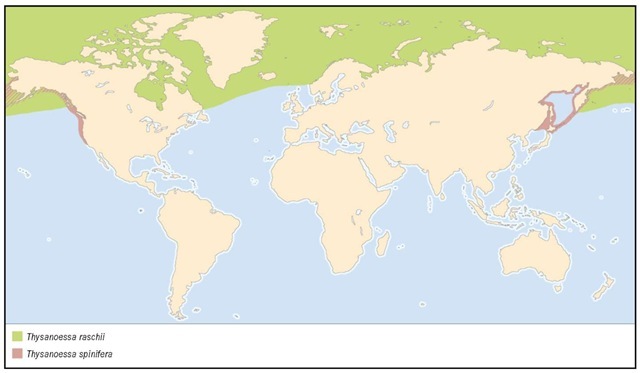
HABITAT
Cool temperate to Arctic regions, near shoreline, from the surface to about 984 ft (300 m) in depth.
BEHAVIOR
Tends to remain below 328 ft (100 m) depth in the winter. In the summer, resumes its diurnal vertical migration and surface swarming.
FEEDING ECOLOGY AND DIET
Diet is primarily phytoplankton; little copepod feeding observed.
REPRODUCTIVE BIOLOGY
Spawning occurs in the spring in the temperate zone, and during the summer in colder waters. Maturity reached in the second year; individuals generally participate in two spawning seasons. Lifespan is two years or more.
CONSERVATION STATUS
Not threatened.
SIGNIFICANCE TO HUMANS
Experimental fisheries in the Gulf of St. Lawrence, Canada.
No common name
Thysanoessa spinifera
FAMILY
Euphausiidae
TAXONOMY
Thysanoessa spinifera Holmes, 1900.
OTHER COMMON NAMES
None known.
PHYSICAL CHARACTERISTICS
Approximately 0.75 in (1.9 cm) long.
DISTRIBUTION
North Pacific Ocean, from the Americas to Asia.
HABITAT
Cooler coastal waters over the continental shelves.
BEHAVIOR
Swarms at the surface during the day from spring through fall. This behavior increases surface predation, and it is not known what benefit outweighs this disadvantage and has led to this behavior.
FEEDING ECOLOGY AND DIET
Diet consists of phytoplankton and zooplankton. Predators include salmon, rockfish, seabirds, and whales.
REPRODUCTIVE BIOLOGY
Lifespan is about two years.
CONSERVATION STATUS
Not listed by the IUCN. One of the most common krill species along the West Coast of North America, where they provide up to 80% of the diet of some whale species.
SIGNIFICANCE TO HUMANS
Among the species harvested in a controlled commercial fishery in British Columbia. Studies have been done to determine the feasibility of establishing fisheries off the California coast.
